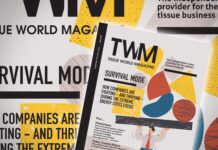
If we wanted to choose a ‘Word of the Day’ in this edition of TWM it would have to be this one … double.
It refers to growth and potential growth, and what makes it so interesting for the industry is its contrast from the far more familiar descriptions and predictions usually employed … slow, steady, surge, retraction, levelling off, and so on. It occurs tellingly from tissue business at opposite sides of the world, as we enter a pre-post-pandemic period in which optimism about tissue’s new future is strong.
Brazil – the world’s sixth most populous country with a young population of 212.6m people, and the world’s fifth-largest country by area – has all the requirements for seriously increased tissue take up. It’s one of the BRICS, the impressive global co-operation of advancing nations along with Russia, India, China and South Africa. While some of those nations continue to surge, the story was a different one for others.
Brazil has seen two major depressions in the last ten years. The pandemic struck at the end of a decade of stagnant economic growth, increasing unemployment, poverty and inequality. Tourism slumped, and Brazilians have been earning less, spending less, and socialising less. For sure untapped potential is in abundance, but traditions, habits, depressions, politics … all seemed to conspire to thwart development. But there is a new story emerging in our Country Report. Daniel Signori is Technical Director at Mili, one of Brazil’s leading tissue manufacturers. His is a familiar story of opportunity seized in the wider distress of the pandemic, allied to a sound and dynamic business strategy. The result? Mili grew 18% in 2020 – and expects a 10% increase in 2021. Investment has followed, rather than attempted to predict, changes in consumer habits that are expected to stay for the long-term. And then Euromonitor’s wider analysis states that given demographics, income, product availability and consumption culture, it would be a reasonable assessment that the market could double its present size. It’s a firming up of emerging trends. As the surges of 2020 settled into the still rising but levelling off growth curves of this year, a significantly larger market became certain. But how much larger?
Euromonitor goes on: “Habit persistence remains a key component of future growth, meaning that once consumers are engaged with tissue there is an overwhelming tendency to continue purchasing. This is the area where the influence of the pandemic presents a huge opportunity beyond the windfall 6.5% value growth reported in 2020, namely, an opportunity to broaden the appeal and usage of tissue products beyond the confines of what came before.” To look further ahead, PwC’s list of the 10 countries that will dominate the world’s economy in 2050 puts Brazil at fifth, behind China, India, the US, and Indonesia.
The route map for a reshaped world
The other ‘double’ comes from China. Tissue World’s recent Virtual Conference 2021 hosted 24 speakers in six sessions exploring critical insights analysing how the tissue market is preparing itself for change and emergence from the pandemic.
Key topics included consolidation, sustainability, drivers for tissue business post-pandemic, global influences and trends, risk and resilience, consumer behaviour, manufacturing process developments, fibre and energy, converting solutions, process automation and optimisation. Hampus Mörner, Senior Consultant at AFRY Management Consulting, addressed global pulp dynamics. Tissue is now the most important end-use segment for market pulp at 40% of the sector and is the predominant cost driver for tissue production. In terms of end-use almost 40% is in China, 25% in Europe and 10% in North America. This share will only continue to grow, with, he predicts, Chinese dominance: “In the next few years if all these projects in China are realised, domestic pulp production … might double.”
Our conference report is in MarketIssues.

































